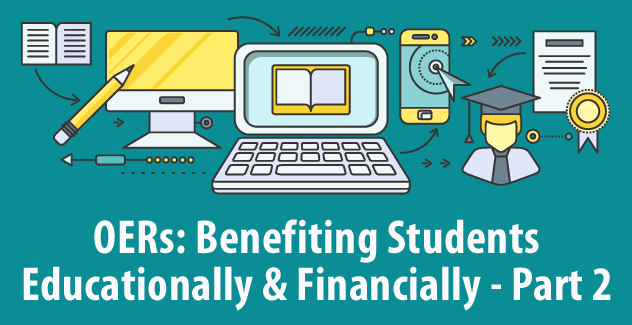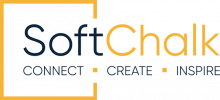
This is the second of two blog posts, written by Lane Gunnels from South Louisiana Community College, discussing how education has evolved over the years and how the responsibility of the teacher has grown. Technology is a big part of both of these and the first post examined how technology is being incorporated into online education and key factors to consider when creating online content so that it is beneficial to both the student and teacher. This second post dives into finding appropriate OERs and how they have impacted students.
OERs: Benefiting Students Educationally and Financially—Part 2
In my first post I wrote about the need for having to adjust for the continually rising costs of attending a college or university. Using OERs is a great weapon for helping to combat this issue. Since there is difficulty in finding appropriate OERS for CTE programs like the electrical technology program I teach at South Louisiana Community College, SoftChalk has become an invaluable tool for me.
In addition to fighting the tide of rising costs, there can be no sacrifice on the quality of material or the instruction provided for students. I firmly believe that the more the price of education goes up, the more responsibility we have, as educators, to provide ever improving “product” to our “customers”.
In trying to find the balance between combating cost increases while maintaining quality content for my students, the implementation of SoftChalk Create to design my own OER had more impact than I could have imagined. This second post is going to highlight some of that impact on my students, the program and myself. Please keep in mind that these results and insights are unique to me and the students I teach at SLCC. I cannot guarantee the same results for anyone else; you may be able to achieve more than I ever imagined if you are on a similar journey.
The impact on my students.
I think the most important result of writing my own content through SoftChalk was the streamlining of information that is being provided. Textbooks have a tendency to drone on and it is not uncommon for CTE students to have poor reading skills. This means it can be difficult for them to find the thesis in a passage or chapter resulting in barriers to their understanding of key concepts. The conciseness of the content provided while using SoftChalk helps some students overcome this particular barrier. I have also noticed that my students seem a bit more eager to complete the reading assignments once they realize they do not have to read chapters that can be several dozen pages long. Lengthy passages cause these students to get bogged down mentally and lose focus. By keeping the content precise, bite sized if you will, they are able to comprehend at a faster pace and complete their assignments not only quicker but, also with improved scores. This has built their confidence and increased their thirst for knowledge.
The addition of media to my lessons has created a new level of engagement with my students. Yes, I am aware that there are digital textbooks that are available with video links embedded in them or that textbook publishers offer digital resources. These, however, come with a financial cost. With SoftChalk I am not only able to choose the particular content I want to use, I can provide it while not requiring my students to pay additional textbook costs. I constantly receive comments from new students about how much the added media helped them grasp concepts that words alone were not driving home for them.
One of the impacts that came about with the elimination of textbook costs was the inclusion of student tool kits. I require the students to buy the tools they need in order to develop the necessary skills to become electricians. I was able to work with a local electrical supply warehouse and our institution’s bookstore for my students to be able to purchase their tools through said bookstore. These tools are from an established, reputable manufacturer and come with a lifetime warranty. I do heavy recruiting for the program throughout the year and when I inform potential students and/or their parents that there is a tool cost, but no textbook cost, I generally get positive responses. Investing in tools that they can use for years is an easier pill to swallow than purchasing a series of textbooks that will not be used again once they have completed the program. The other benefit of going through the bookstore is that those who qualify for financial aid can apply it to their purchase. This also allows for a revenue stream for the bookstore even with the elimination of textbooks.
The last impact on my students that I would like to share is the added opportunity to develop and enhance their computer skills. It is almost cliché to point out how much of our lives and careers now involve the use of computers. There are some instructors (and I am writing from personal experience with a few) who hold to the belief that computer skills are not necessary for students enrolled in certain CTE programs. I completely disagree with this viewpoint. Even if they may not use a computer for the actual work, there are aspects of the job where they will need these skills, such as submitting a time sheet for example. By requiring my students to access their lessons online, I expose them daily to using a computer, a tablet, or a smart phone. Thus ensuring our increasingly digital world becomes comfortable and familiar to them.
The impact on the program.
The initial impact on the program was the increased amount of hands-on activities I am able to provide. The streamlined content gets us into the lab earlier in the program and provides more time to develop the skills and concepts that they have been reading and studying. I have been able to add over 30 projects to the program, 20 of those in the last year alone. Students are installing more circuits and are attempting more troubleshooting exercises than ever before and with greater confidence.
I have been able to easily modify the content in the program as a result of using SoftChalk. The electrical technology field is constantly improving and expanding, with new equipment and designs being introduced regularly. This means that my program cannot keep doing things “as it’s always been done” and becoming stagnated. The flexibility of content management that SoftChalk provides is invaluable in keeping the program up to date.
The overall result is that the students in this program are now some of the most comprehensively trained people we have ever produced. I don’t know about you, but knowing that future electricians are getting their careers started with stronger educational foundations gives me a certain peace of mind when it comes to who will be wiring the buildings I could find myself in.
The impact on me.
This impact is hard for me to put into words. I know that my instructing skills are sharpening due to the fact that I am now writing my own content and conducting a lot more research during the process. This has resulted in a greater retention of information and a refining of my delivery when lecturing or demonstrating.
More and more I find myself gaining a deeper understanding of how to better connect the subjects throughout the program and I am developing a better delivery of content to my students. I know this would occur anyway as I teach through the years, but I am convinced it is the work I am doing to develop the OER for my students that is responsible for the pace at which I am growing as an instructor.
And to close the circle, the personal impact is still an impact on my students. While improving as an educator, the students also get the benefit of receiving a higher quality of instruction passed on to them.
In conclusion, I would like to address a question that was posed in a leadership course I took a while back. It was in our textbook, but it stuck with me. Kouzes and Posner (2006, p.6) asked, “How am I going to fully use myself to make a difference in the world?” I believe that education is the key to reducing poverty and every person that enters my program will have the potential to never go below the poverty line. My students get all of me with every lesson I write and every lecture I give and every demonstration I provide. That is how I make a difference and how I plan to leave a small part of the world better than I found it.
Breaking away from the status quo is risky, but the rewards are worthwhile. I refuse to be content with modest gains in student success while they are enrolled, or even afterwards when they leave my tutelage to begin their careers (Phelan, 2016, p. xx).
References:
Kouzes, J. M., & Posner, B. Z. (2006). Christian Reflections on The Leadership Challenge. John Wiley & Sons.
Phelan, D. J. (2016). Unrelenting change, innovation, and risk: Forging the next generation of community colleges. Lanham: Rowman & Littlefield.
 Lane Gunnels is currently the Lead Instructor for the Electrical Technology Program for South Louisiana Community College. He has been teaching higher education for ten years and believes in using innovative methods to deliver content. He is fond of saying, “Just because the message may not change doesn’t mean the delivery method cannot change.” A U.S. Navy veteran, Lane took his military electrical training and experience into the classroom and has proceeded to re-design and modernize an electrician program. He has been the recipient of the SLCC “Faculty Excellence in Teaching” award and is also the first CTE instructor for SLCC to be elected the Faculty Senate President. As well as being the first 2-year term president, Lane is the first president to be elected from a campus outside of the main SLCC campus. His dedication to his students, demonstrated by his efforts towards innovation, has helped him earn these accolades.
Lane Gunnels is currently the Lead Instructor for the Electrical Technology Program for South Louisiana Community College. He has been teaching higher education for ten years and believes in using innovative methods to deliver content. He is fond of saying, “Just because the message may not change doesn’t mean the delivery method cannot change.” A U.S. Navy veteran, Lane took his military electrical training and experience into the classroom and has proceeded to re-design and modernize an electrician program. He has been the recipient of the SLCC “Faculty Excellence in Teaching” award and is also the first CTE instructor for SLCC to be elected the Faculty Senate President. As well as being the first 2-year term president, Lane is the first president to be elected from a campus outside of the main SLCC campus. His dedication to his students, demonstrated by his efforts towards innovation, has helped him earn these accolades.
Lane has been using SoftChalk for several years and freely admits that he would not be as successful as a classroom innovator if it were not for the features and accessibility of SoftChalk.

Leave a Reply